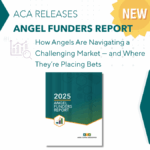 All parties in early-stage investing understand that early financial projections will prove inaccurate. But even if inaccurate, a company’s financial projections can provide investors insights into how well they understand their business and market. Below, I discuss six different checkpoints that angel investors, regardless of their experience, can use to evaluate an investment opportunity better.
All parties in early-stage investing understand that early financial projections will prove inaccurate. But even if inaccurate, a company’s financial projections can provide investors insights into how well they understand their business and market. Below, I discuss six different checkpoints that angel investors, regardless of their experience, can use to evaluate an investment opportunity better.
Checkpoint 1 – Make Sure Forecasts Exist
No matter the company’s age or fundraising stage, every company should be able to provide forecast models that aid investors’ decision-making process. Angel investors should be extremely skeptical if a potential investment does not have the forecast models discussed. If the entrepreneur has not taken the time to create the models, how do investors know they have considered the costs of their strategy, their ability to reach revenue goals, or when they will require additional cash infusions?
Checkpoint 2 – Do the Models Match Their Story
The forecast models should help investors evaluate whether the entrepreneur is building a business that matches their growth story. If the company is building the latest in AI, do they show significant investment and costs in computing power? If they are a B2B SaaS business, does their investment into sales & marketing match their growth strategy? Founders are often also the key salesperson, but does their model reflect additional sales hires as the plan scales? Or do they plan to rely on marketing to generate leads, and if so, does that match their sales & marketing spending plan?
At the earliest stages, investors are unlikely to evaluate the forecast accuracy, as the company may not have the history to prove their assumptions are accurate. However, investors can evaluate whether the story for growth matches the forecast models, revenue plans, and expense forecasts.
Checkpoint 3 – Does the Model Show Depth of Thought
Assuming the model exists and matches their strategy, the next checkpoint should be the depth of thought within the plan. When reviewing their forecast model, investors should find the underlying drivers of the business clearly defined. Using the AI example above, are they projecting a flat amount per month or considering the number of requests to Open AI multiplied by the cost? Are they forecasting salaries but not including associated payroll taxes? Are they forecasting a flat sales amount but not considering whether they are selling a number of users, a flat license per client, or based on usage?
In some spending areas, an assumed flat amount per month is reasonable. However, when looking at the key revenue and expense drivers, the model should provide investors with insight into how the company plans to achieve its goals.
Industry-specific metrics are another method to determine if the company fully understands its business model. In SaaS, the metrics are well-known, published, and easily referenced online. These companies are likely too early in their lifecycle to be able to accurately measure Customer Acquisition Cost (CAC), Lifetime Value (LTV), or renewal percentages. But if they are assuming 100% customer retention and no client ever churning, that signals that they have not fully considered the realities of their business model.
Checkpoint 4 – Cash is King
Models for early-stage companies in SAAS or capital-intensive industries need to highlight the significant variances in timing between revenue/expenses and associated cash flows. Along with checkpoint 2 on the model matching their business, and model should also specifically forecast cash generation/burn and a cash zero date. As investors evaluate the model, do they have a clearly defined date when they switch to positive cash flow or need to fundraise again? If they are going cash flow positive within the timeframe of the investment, does that signal they are growing at a rate to provide venture returns? If they require additional capital, is the next investment in a reasonable timeframe after the investment.
Checkpoint 5 -Unit Economics
Unit economics combines checkpoints 3 and 4 but at the individual customer level. If the company plans at a detailed level and understands its cash flows, it should clearly show that each customer can be profitable. The model should include calculations tracking unit economics and which levers are key in making a single customer profitable. With early-stage companies, the low volumes associated with initial sales or production make immediate profitability challenging. But if the first customers are not profitable, which levers does the company change over time to make customers profitable in the future? And once profitable, are they able to maintain that profitability over time?
Checkpoint 6 – Who are they hiring and why?
Who, how, and when a company plans to hire can also provide great insight into the level of diligence in their plan. At the initial stages of a company, every hire can exponentially increase the scale at which a company can grow. As investors review their hiring plan, do the planned hires reflect the best use of the investment to achieve the scale required? Do they have a list, in priority order, with titles, compensation and timing showing what they feel is required? Lastly, do they include projected option grants tied to these hires with realistic ownership percentages? The forecast model should include a grant plan showing the proposed option pool and how those options are allocated to new hires or refreshing options to existing team members. A forecast model without a grant plan is incomplete, and investors will struggle to know if the plan is achievable without that key information.
Summary
Reviewing the checkpoints above, the common themes are whether they (1) exist and (2) have been thoughtfully created. If the company has done both of those, the investor can ask more insightful questions and make a more informed investment decision. If the angel investors decide to move forward with funding, all parties have the starting point of a plan that can be measured over time and adjusted if they fail to achieve the planned growth.
Author:
Tim Debone, President of Strategic Finance at Bagchi Group, boasts extensive experience in finance, including roles at Intel and NetSuite. With a BSBA and an MBA, he excels in financial analysis, ERP implementations, and strategic planning. At Bagchi, he drives the Financial Services division, offering tailored solutions to various clients.







